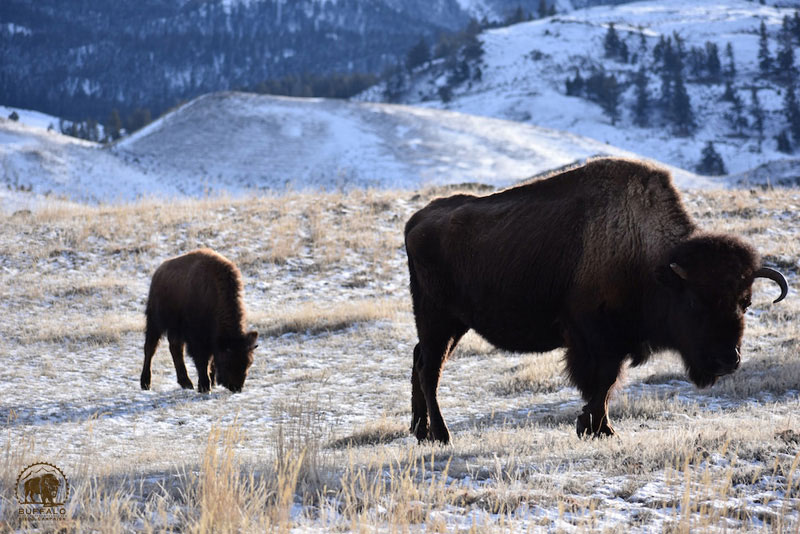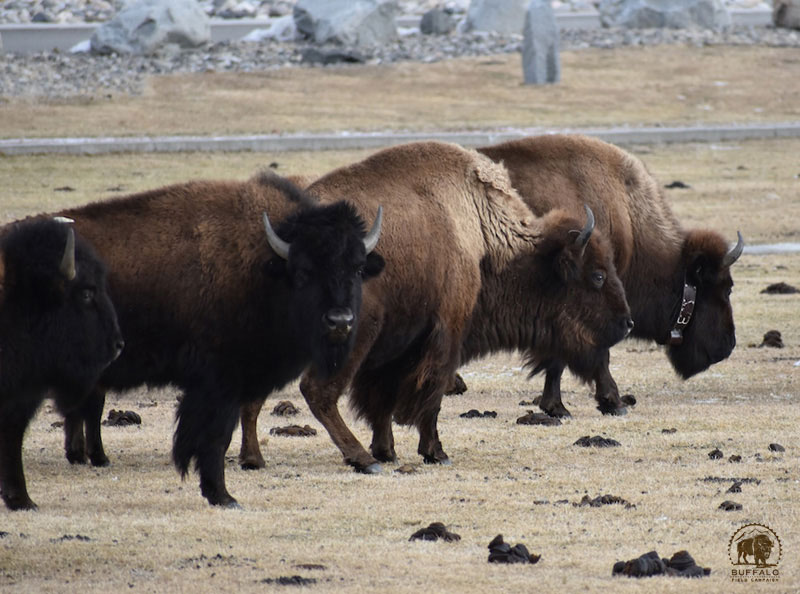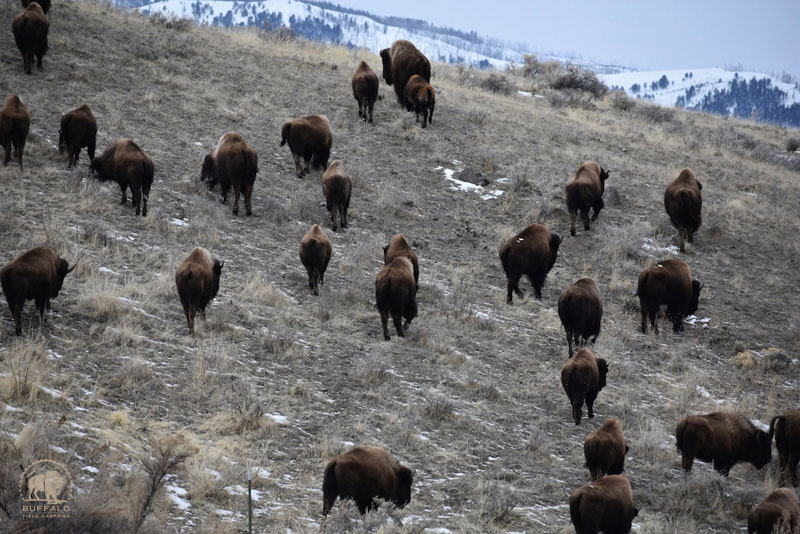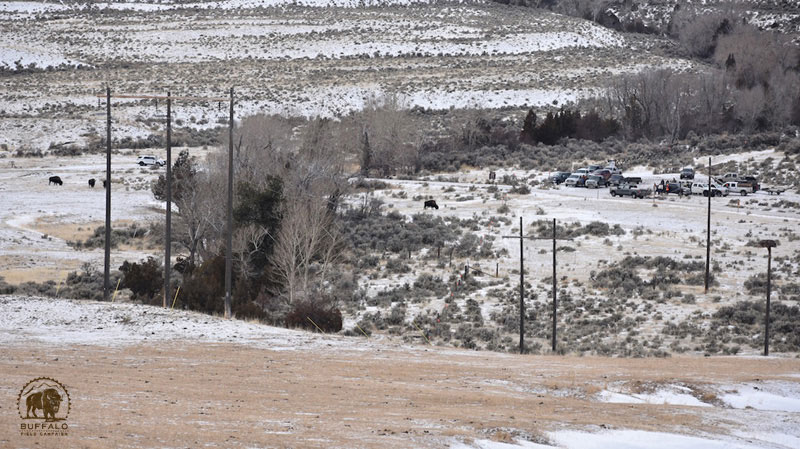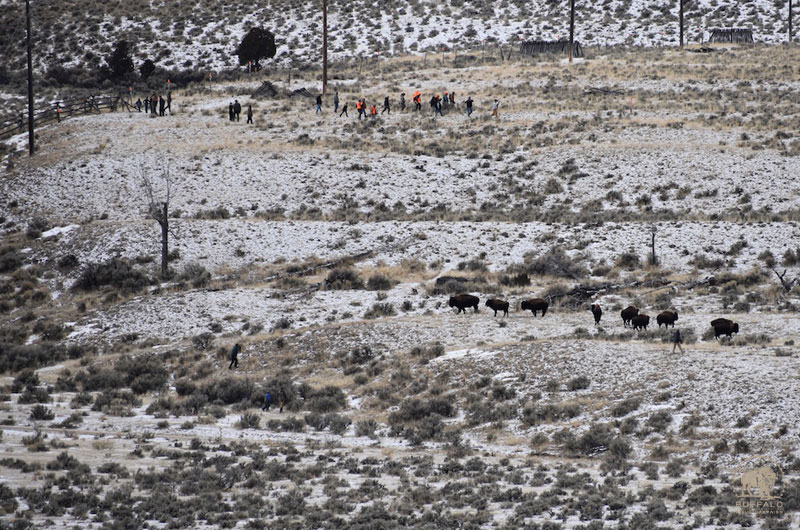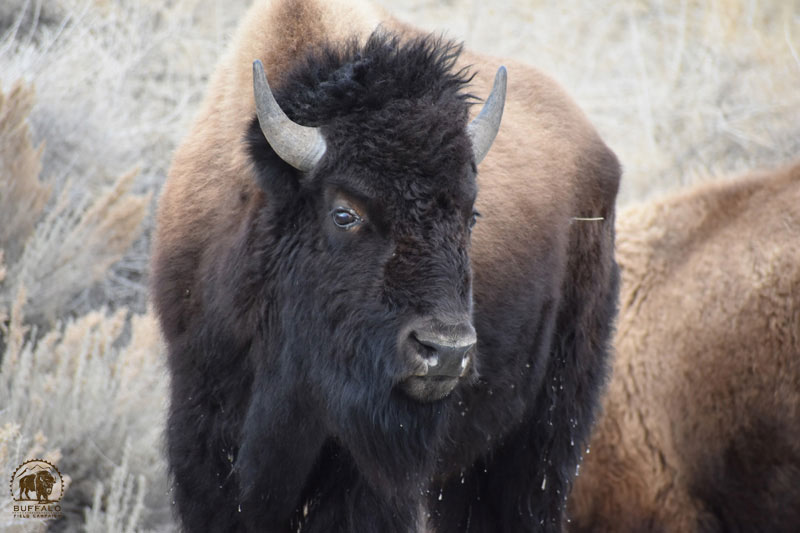BFC photo by Stephany Seay.
She was showing signs of seriously ailing health. Skin and bones. And still taking care of a six-month old calf. Yet, she pressed on, her baby never far from her side. The two of them were spotted alone, and then would meet up with other buffalo, break off again, then finally, united with a family of seven who they stayed with until their dying day. Maybe she was trying to bring her calf to others to care for, because she knew her time was short. Still, she pressed on. In fact, for the week our Gardiner crew was keeping an eye on her, she was leading the way. For a while, her family was nearly the only buffalo edging towards the danger of Yellowstone’s north boundary. But, only for a while.
Collared female, S3, who we have seen in the Hebgen Basin a few times this winter, is proof that the Central herd, who migrate both north and west, are doubly threatened by management actions. She fled the Hebgen Basin after losing family members to hunters, and now, in the Gardiner Basin, she is in danger of either being hunted or captured for slaughter. BFC photo by Stephany Seay.
The previous week, when we first opened our Gardiner camp, close to two-hundred buffalo were starting to appear. But, they’d hang around, still inside the Park, and then be gone again, only to appear in earnest yet another time. Soon, more and more buffalo arrived, moving down into the Gardiner Basin in multiple groups. Many hung around in the high hills, poised for migration. On one particular day, they began moving to lower elevation, heading north into the Basin, towards danger. On this day we counted over four-hundred buffalo. As we watched them arrive, Bob Marley’s “Exodus” was playing. Movement of the people. Down from the high hills they came. Such a bittersweet sight. One we should all be celebrating, and in our hearts we were, but we knew what dangers lay ahead for them if they continued on this path. One group of buffalo we were with revealed members of the imperiled Central herd; (Take Action!) a radio-collared adult female, “S3” was here. We’d already seen her and her family on the west side, in the Hebgen Basin. They had lost family to hunters over there more than once. But, she was proof that the Central herd, who migrates both into the Hebgen Basin (west) and the Gardiner Basin (north) are doubly impacted by “management” actions. In her company, we spotted no less than five young bulls, all with stickers on their backs. These young boys must have been some of the quarantine escapees. This group, along with others numbering around two-hundred were making a bee-line towards Yellowstone’s north boundary, where multiple hunters waited for them in the Beattie Gulch parking lot. We monitored the herds as they moved further and further north. By the end of that afternoon, as the light began to fade, we were certain that the following day would be one of serious bloodshed.
Exodus…movement of the people. BFC photo by Stephany Seay.
That night, a windy, snow blown storm came through, and we knew this would cause the buffalo to move even more. And it did, but not as we had expected. The next morning, preparing ourselves for the worst, we headed out to see where all the buffalo had moved to. Aside from a lone bull and the family of nine led by the ailing mother, we didn’t see a single buffalo. Where had they all gone? No less than four hundred were well on their way the day before, but by morning, the Basin was nearly empty. We drove south, looking for them, seeing no one. It wasn’t until we reached one of our high point lookouts off of Jardine Road, that we saw the tail end of less than fifty buffalo heading deeper into the Park. Something caused them to turn around in the night. Was it the storm? Maybe it was the young bulls who had been tormented in Yellowstone's quarantine facility, warning the others as they got closer to the area of Yellowstone’s trap. Regardless of the cause, everyone - BFC, hunters, game wardens, park rangers — was surprised by their exit, some of us heaving huge sighs of relief, others grumbling in frustration. But, some of the hunters would not go home empty-handed.
The Beattie Gulch parking lot, where hunters wait for this family of buffalo to cross Yellowstone’s north boundary. BFC photo by Stephany Seay.
The following morning, the family group of nine were perilously close to Beattie Gulch. No less than sixteen rigs, full of hunters, were in the parking lot, watching and waiting for them to cross the line. We waited across the Yellowstone River and watched it all play out. The ailing mama was the first to cross the Park boundary. The others seemed hesitant to follow, feeling something was amiss. Not even her calf went with her. The mama was bold, moving over into the parking lot, walking among all the hunters waiting there. Perhaps she was coming to offer herself. As sick as she looked, she would be the one wolves would choose to take. Casting away their hesitation, the rest of the herd eventually followed, walking right down the road in front of all the hunters. Hunters got out of their trucks and started heading up the hill, lining up. The buffalo were still not in a zone where they could be shot. But, while it is unlawful for people to move them into a safe zone, hunters are allowed to haze them into areas where they can be shot. And they did. Humans on foot started to surround the buffalo, pushing them closer into the hunt zone. With their tails up, sensing the danger, we thought the buffalo might bolt for safety, but they were surrounded. The only place for them to go was directly into the line of fire. The hazers moved them into the hunt zone and the hunters, lined up and ready for the first chance, opened fire. Within a matter of seconds, that family was no more.
Surrounded and then hazed into the hunt zone, these buffalo hardly stood a chance. The entire family was killed by hunters in a matter of seconds. BFC photo by Stephany Seay.
These kinds of actions, which cannot be called hunting, are the result of Montana and Yellowstone’s management scheme. Buffalo are currently allowed only small fractions of habitat in Montana, especially in the Gardiner Basin, and hunters are told by Yellowstone that if they don’t kill them, then the Park will round them up for slaughter. In a race against the trap, on a small landscape crowded with competing hunters, a sense of urgency causes those who come to hunt buffalo to take every opportunity to kill any buffalo who dares cross Yellowstone’s boundary. This is the infamous Beattie Gulch firing line, a result of Montana and Yellowstone’s ridiculous Interagency Bison Management Plan. Without a resident population of wild, migratory buffalo in Montana, hunters may spend days or even weeks patrolling Yellowstone’s boundary, just waiting for the gentle giants to dare walk out of the Park. For Native hunters, many who come from impoverished conditions, traveling great distances to hunt under treaty right, this is a painfully expensive endeavor; not just having to spend so much money on hotel rooms, meals, and travel, but, more importantly, the greater cost of ensuring that any buffalo who walks out of the Park has very little chance of staying alive. As more Nations come to exert their treaty rights, and fewer buffalo are on the landscape, Montana and Yellowstone have set up a recipe for disaster.
Threatened by traps and guns, it is no small task to help the country’s last wild buffalo reclaim the ancestral lands that are their birthright. BFC photo by Stephany Seay.
As a larger disaster was narrowly averted in the Gardiner Basin, more buffalo fell to hunters in the Hebgen Basin. Within two days, no less than fifteen buffalo were shot, most barely five hundred yards from Yellowstone’s western boundary. The survivors, once again, fled into the general safety of the Park, but not before one was struck and killed by a vehicle along U.S. Highway 191. Having to retreat to safety one more time, they will return again. Migration is a huge part of who wild buffalo are, one of their many gifts. Humans can try as they may, but no management scheme will ever stop wild buffalo from following their ancient, wisdom-filled instincts.

